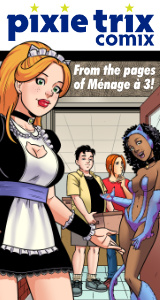Lightning Lady tells her friend Miss Match all about finding her boyfriend in the arms of another woman — who also happens to be Lightning Lady!
Transcript
Evil Inc – April 3, 2024
By Brad J. Guigar
Panel 1
Narration: Evil Inc Breakroom, Some Time Later
Miss Match: "Wait... So, he was cheating on you with you??"
Lightning Lady: (Looks down, visibly distressed.)
Panel 2
Lightning Lady (narrating over a scene of a group of Alternate-Universe Lightning Ladies in Different Outfits and Styles): "It's a long story, but some time back*, Marquis teleported some alternate-universe versions of me. We thought we managed to get everyone home, but we musta missed one.”
*Evil Inc After Dark #16
Miss Match: "...So, you beat the stuffing outta her, right...?"
Panel 3
Lightning Lady: (Narrating a scene of her and Angus having a tender conversation.) "Just the opposite."
Lightning Lady: "Angus... you're a good guy. Losing Flashback left me scared to let another man into my life..."
Panel 4
(Lightning Lady talks to Angus While Alternate-Universe Lightning Lady Stands Beside Him)
Lightning Lady: "You deserve someone who can give herself to you completely. Someone like her."
Panel 5
Miss Match: "You... you gave up?!?"
Lightning Lady: "How am I supposed to compete with all of this?!" (Gestures at herself in exasperation.)
© 2025 Brad J. Guigar. All rights reserved. Evil-Inc.com

Blank Label Comics garnered 11 nominations in the 2006 Web Cartoonists’ Choice Awards, which were announced
yesterday.
Starslip Crisis, by Kristofer Straub, took 5 nominations — Outstanding Newcomer, Outstanding Black-and-White Art, Outstanding Use of Flash, Outstanding Web Design, and Outstanding Science Fiction Comic.
Kris earned a
sixth nod for his writing on Starslip Crisis, Checkerboard Nightmare, and Modern Humor Authority.
Wapsi Square, by Paul Taylor, earned two nominations: One for Outstanding Black-and-White Art and another for Outstanding Character Art.
Shortpacked!, by David Willis, got two nods: One for Outstanding Comedic Comic and another for Outstanding Web Design.
Ugly Hill, by Paul Southworth, was nominated for Outstanding Character Art.
Voting for the Webcartoonists’ Choice Awards began on June 12 and will end on July 10. The winners will be announced July 17.
 Blank Label Comics garnered 11 nominations in the 2006 Web Cartoonists’ Choice Awards, which were announced yesterday.
Blank Label Comics garnered 11 nominations in the 2006 Web Cartoonists’ Choice Awards, which were announced yesterday. 

























